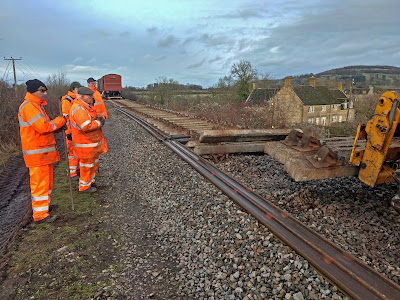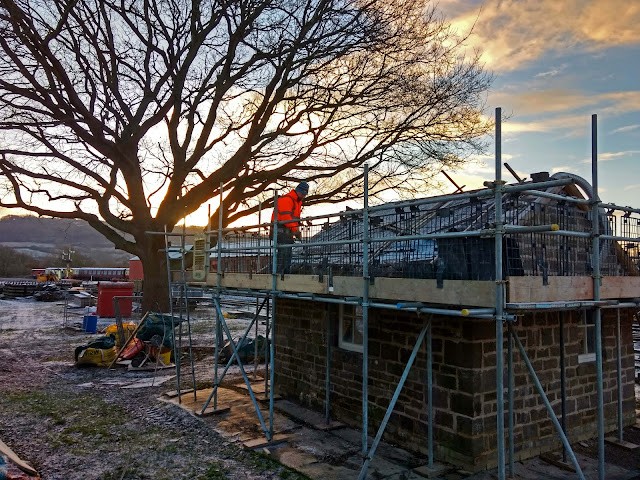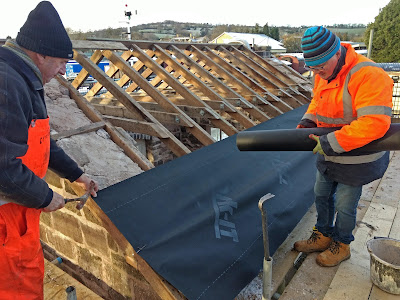Saturday at Didbrook
Wet and windy again. Some of us have had this three working days in a row, and were a bit disgruntled first thing. The wet caught our Transit out too, it's only got road tyres and two wheel drive.
During a simple 3 point turn, it would only do one point, and got stuck with spinning rear wheels.
Some extra ballast under the driving wheels, and 8 men pushing, got it back on the haul road. The unfortunate driver (ahem) was mercilessly ribbed afterwards.
We have sold both of our 4 wheel drive Landies, so are currently making do with two wheel drive Transits, but they are not really up to the job along the track, what with the many reversals that we do.
We need something that can carry sleepers, have a crew cab, and 4 wheel drive. Is there such a thing?
 |
| Staying safely on the middle of the haul road, the Transit is left at Stanton and the gang have to walk the rest of the way, almost to the viaduct. |
Two jobs were earmarked for Saturday.
Job 1:
A Telehandler and three supporters, to remove the rest of the 'economy' sleepers and 4 pairs of rail.
Job 2:
Clear rails of excess ballast at Stanton, for the other 8 gang members.
 |
| Shovelling at Stanton |
While the volunteer gang replaces 1/4 mile of sleepers at Didbrook this winter, a professional gang will re-stress the CWR extension from the viaduct to Broadway, and deal with an excess of ballast at Peasebrook and Laverton. The volunteers can't do everything at once, so sometimes we have to resort to contractors as well.
We had to clear between MP8 1/4 and MP8 1/2, so that the bottom of the rail was free for stretching. This is basically the area where ballast was loaded for the extension, so there was a lot in and around the rails, left over from the loading operations.
Not a very interesting occupation, and tiring on your back. (But necessary of course)
We took the time to snap this mile post (L), which must qualify as the most unauthentic along the whole line.
Left: A folded sheet of steel, screwed to a piece of round, and stick on numbers. Our old style.
Right: A carved wooden top, lead sheet protection, cast numbers, on a length of bridge rail. Our new, authentic style.
As you may have read on the drainage blog, there is a concerted effort going on to replace the former with the latter. They are doing really well, hope you notice them as you travel along our line.
After 1/4 mile of shovelling we got rather tired, but did reach the Stanton road overbridge, which marks the limit of the loading area.
In the background is the aqueduct, which we completely renewed a while back. We are dealing with the Preston Road bridge as we write, and word has it that our 15 arch viaduct will receive major attention next winter. So we are dealing with our bridges, one by one.
The end of the quarter mile coincided with lunch time, so we travelled back to Didbrook to join the Telehandler team for lunch.
 |
| PWay fare: Brownies, with an ovoid. Living off the land... |
David made himself very popular by bringing, unannounced, a box full of brownies, home made. They were so good that people asked about their provenance. Home made, David said proudly.
The rain petered out after lunch, and we climbed back down to the trackbed to watch Dave in the Telehandler clear up what was left of those 'economy' sleepers, right back to Didbrook 1.
All the sleepers had been tipped out of the ballast to loosen them, and the rails levered into the six foot.
Dave would then pick up 8 sleepers at once. He did this by picking up what would fit on the forks in the first scoop, and then.....
...... dropping this further up, to create a higher pile.....
..... which he then managed to scoop up, hopefully grabbing eight sleepers this way, but sometimes only seven. But a goodly load anyway.
This bigger load was then driven back down the trackbed, where a large pile was being made.
The bogie flat is currently full, hence the pile to one side.
The sleeper removal didn't need many volunteers, so we were allowed to go home mid afternoon, even as Dave continued to scoop up concrete. He had at least another 8 trips to do, we calculated, plus 4 pairs of rails to drag back, if the daylight permitted it.
We learned later that Dave did remove all the sleepers, but that failing light stopped the removal of the last rails. Once these are gone, a contractor will move in to grade the site.
Tuesday in the shed.
Back to fabricating. Neal on the Broadway uprights, and John with yours truly on the ladder and platform for the yard lamp. They needed cleaning and painting, after manufacture.
 |
| Platform after assembly of the parts made by John. |
 |
| Ladder stripped of mill scale, and ready for cleaning. |
The ladder was cleaned with a rotating brush outside (because of the dust) while the temperature was minus 6. At one point we had to nip inside for a hot cuppa to revive, but the job got done.
 |
| Neal preparing the half rounds for fitting to the posts |
 |
| Half way there. The boxes are now complete. |
While Neal ground down the excess weld material from around the half round strips, John was painting the long ladder for the yard lamp with a special primer.
Didbrook:
The contractor is now on site, and has started clearing and levelling the trackbed.
 |
| Digging up the spent ballast. |
 |
| Spent ballast ready for loading. |
Pictures from Paul, with thanks.
Wednesday with the Usketeers.
We drove to Winchcombe before sunrise, with a sub-zero temperature and frost on the ground. It's winter!
People were wrapping up warm. The PWay job today was out along the line on the Broadway extension. There was more clearing of ballast, ready for stressing, and this soon made them warm.
Two Usketeers were already in the building, enjoying a cup of coffee from the flask, and a doughnut. Dave was hotly expected, as he would have a roll of the roofing felt that we wanted - all black. We found some at last!
But there was no Dave, where was he? Stress. This was to be the day we start to put the roof on.
It turned out that Dave had had a problem with his bed - a reluctance to get out of it, that is. And we all thought he'd had an accident, with all that ice about. But Dave came, roofing felt under his arm - phew! We could make a start.
In the picture you can see Jules sweeping the frost off the scaffolding planks. It was slippery up there. Then we set about removing our carefully installed and almost watertight tarpaulin, ready for the proper stuff - 'Sark it' it was called. And sark it we did.
We had two tarps on the roof, and in this picture you can see that one has been removed already, while the sun hasn't even come up yet.
A lot of battens and nails had to come out, so that we had a clean surface for the felt. Originally the hut didn't have roofing felt, just bare slates on the trusses, but we thought a layer of felt would be an advantage, while still possible, so we spent £40 on it.
Here you see Jules and Paul tacking down the first sheet. You start at the bottom, and a handy dotted line on each sheet tells you where the overlap goes.
Here goes the second row.
We went to a lot of trouble to find roofing felt that had no writing on it, at least underneath, because say a white felt with blue branding on it is not going to look very 1850 when seen from underneath.
The other side got a row on as well, and when both sides were near the top, one row was folded over the apex, and all was tacked down with temporary battens.
 |
| Finally the sun rose, and it became pleasantly warm. |
With the felt on and battened down all round, we were completely dry inside for the first time ever. Even with the tarp there were leaks, and it had a lot of pinholes, having first served over the container at Hayles Abbey halt, when the same team was building that.
Paul started to measure up, which was quite complicated.
Paul had to substitute the temporary battens for those that support the slates. These have to be at exact distances, all measured from the bottom row, otherwise you repeat mistakes.
In the picture he is fitting half slates to the gable end.
Half slates also line the bottom edge - split across the middle, those on the end down the middle.
A little shot of Paul placing slates split down the middle along the gable edge.
Paul and Dave were working along the shadow side.
The other side though was sunny - here you can see the station side with its felt fully fitted and battened down.
Mid afternoon the first 5 permanent battens had been fitted, and Paul and Dave were hammering on slates.
 |
| Paul finds something unpleasant in his glove.... |
At the end of the day this was starting to look like a slate roof. We have enough original Usk slates at 12ins wide to do one side.
The other side will be covered with 10ins wide slates, which we had in store for quite some time, possibly from the former Exminster box, which was recovered, but never rebuilt. So they will find some use after all. Another item from Exminster box that was used was the cast iron lamp vents that stick through the roof. These are now on the box at Broadway.
At the end of the day, and with light starting to fail again already, this is what you could see.
Once the battens have been correctly spaced and the first few slates attached, the rest can follow quite quickly.
To make quite sure that we will not overrun the 2 month scaffolding hire, we are going to double up and do a second day tomorrow. Maybe also next week - we will have to see availabilities, and also the weather. At the moment we are very lucky, as it is cold, dry, and relatively windstill. Pretty perfect really.
Last but not least, we have another picture from PWay Paul of today. The gang spent the day clearing ballast off the rails on the Broadway extension up to MP6, and also ferrying up some stillages for use by the contractors stressing the track.
The stressing operation has been announced to the public by this notice on a footpath crossing near Laverton, warning walkers that the pads will be removed.
Can't read the notice?
See you again soon!



























Re the vehicle replacement : Have you looked at the Toyota Hilux doublecab ute, with tray. It's 4WD and should do everything you want. Very popular with farmers and tradies around here !
ReplyDeleteGreat to see the sudden progress on the Usk hut! Those slates are looking good. Hope the weather holds to allow more work. I guess the chimney will be the bit that takes most time, though...
ReplyDeleteWonderful progress on all fronts.
ReplyDeleteI found that when our house was re-roofed, that besides scaffolders, slate layers also required the obligatory radio to in operation whilst working or else they stopped work too!
That was another house ago. Now our only worry is the (man made) river at the top of our garden of which the water level is above, not only our back garden but if the bank breached, would be half way up the back of the house. Hence flood defences!
There is something about recycling slates that makes the building look 'right', somehow, where new slates do not.
Regards, Paul.
Usk tile roofing commences - Yahoo. Well done everyone involved & greetings from 'down under'
ReplyDeleteKR Jon
We were back today, and have almost completed one side. A report will follow next time. No radio though...
DeleteRe the 4x4, Mercedes do a larger 4x4 3.5t truck that could be an option for you, some of the utility companies use them so you may find an end of lease one
ReplyDeleteA fine blog....well done gentlemen.
ReplyDeleteUnimog.
ReplyDelete